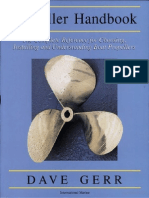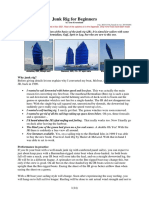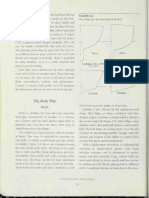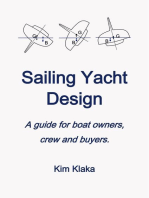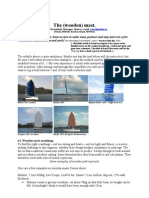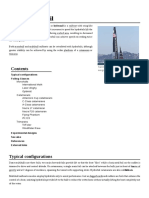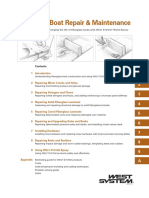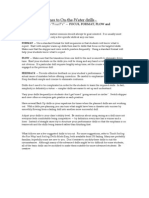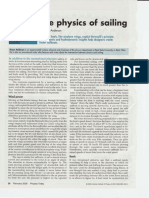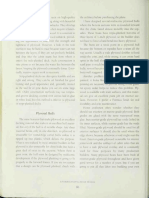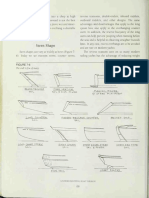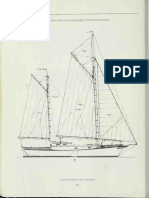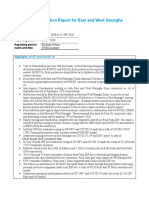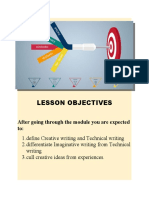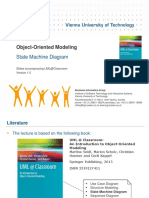Understanding Boat Design 55 PDF
Understanding Boat Design 55 PDF
Uploaded by
Łukasz ZygielCopyright:
Available Formats
Understanding Boat Design 55 PDF
Understanding Boat Design 55 PDF
Uploaded by
Łukasz ZygielOriginal Title
Copyright
Available Formats
Share this document
Did you find this document useful?
Is this content inappropriate?
Copyright:
Available Formats
Understanding Boat Design 55 PDF
Understanding Boat Design 55 PDF
Uploaded by
Łukasz ZygielCopyright:
Available Formats
FIGURE 4-4 Most cmising men and women think the center-
Bulb keel variations. (From Ted Brewer Explains Sailboat board is too much trouble because it must be
Design, by Ted Brewer. International Marine, 1985) adjusted frequently when sailing if it is to be effective,
and because it requires a hole in the bottom of the
H&-*. vJtOTH ^BO\AT boat —an area of possible (probable!) trouble. The
slot for the board may become jammed with rocks or
barnacles. It is also awkward to paint, a source of
leaks, and a home for teredos (wood-boring marine
organisms) on wooden yachts. Another problem is
that the centerboard trunk usually runs smack down
the middle of the main cabin, effectively cutting the
accommodations in two.
A few yachts sport two centerboards, a large board
forward and a smaller one aft. The forward board is
used primarily to reduce leeway, and the aft board is
used for trim. The helm can be balanced by raising
V^eE-i- Ti p •
S\-i/:>.PE.i> - vImiqa m g>E^T 7 one board and lowering another to shift the center of
lateral plane. This is particularly handy when sails are
reefed because the change in the center of effort
caused by reefing can be balanced by adjusting the
boards. Of course, there are now two boards that can
jam, two slots to paint, and two pendants that can
BUl-B V^etU \//\GlAT"lO'4S>
break.
Bilge Boards and Leeboards
Munroe was developing his Presto sharpie style of
husky centerboarders (Figure 4-6). These handsome Bilge boards are simply dual boards set each side
cruisers boasted as little as 32 -inch draft on a length of the cenlerlme. They are usually of high-aspect
of 40 feet and proved to be both fast and seaworthy. ratio, and set at an angle so the leeward board is \'er-
Although the pure centerboard cruiser has fallen out tical when the boat is heeled. They can be as)Tnmetri-
of favor, it still hasmuch to offer the sailor. cally shaped to improve efficiency as well. This t)'pe
The Prestos, and many other centerboarders, use a of board eliminates the centerline trunk, and the
long, slab-sided board, because it is economical, bilge-board trunks are set into the settee fronts,
strong, and simple to build. However, it is not nearly which avoids splitting up the accommodations. Still,
as effective as a streamlined centerboard of high- bilge boards have most of the disadvantages of twin
aspect ratio, which provides much more lift for its boards, although they are not so prone to jam with
area and is the only choice for a high-performance rocks or mud since they sit higher in the hull. In any
yacht. The high-aspect-ratio board does strain the event, they are not popular.
trunk and hull more than the older-style centerboard, Leeboards (Figure 4-8) are similar to bilge boards
so it must be very carefully designed. but are hung outside the hull. The value of this
I^TERAL Pl^NE
43
You might also like
- Lofting A Boat A Step-By-Step Manual PDFDocument221 pagesLofting A Boat A Step-By-Step Manual PDFmauricio matus83% (6)
- Build Your Own SailboatDocument1,095 pagesBuild Your Own SailboatMIRCEA130575% (4)
- The Sailing Bible 2009 - The Complete Guide For All Sailors (Adlard Coles Nautical London)Document96 pagesThe Sailing Bible 2009 - The Complete Guide For All Sailors (Adlard Coles Nautical London)clee9999No ratings yet
- Aerodynamics of Sailing YachtsDocument96 pagesAerodynamics of Sailing YachtsMarcelo MilicevickNo ratings yet
- Searunner Trimarans PDFDocument129 pagesSearunner Trimarans PDFTrix Gaimo100% (3)
- The Propeller Handbook The Complete Reference For Choosing Installing and Dave GerrDocument22 pagesThe Propeller Handbook The Complete Reference For Choosing Installing and Dave GerrEmin KsknNo ratings yet
- Junk Rig For Beginners PDFDocument14 pagesJunk Rig For Beginners PDFGraham WestbrookNo ratings yet
- Arvel Gentry A Review of Modern Sail TheoryDocument4 pagesArvel Gentry A Review of Modern Sail TheoryOrsolyaKaufmannNo ratings yet
- What Makes A Trimaran FastDocument15 pagesWhat Makes A Trimaran FastAlex GigenaNo ratings yet
- The Vintage Model Yacht Group - Vintage Class RulesDocument20 pagesThe Vintage Model Yacht Group - Vintage Class RulesIsmar AdrianNo ratings yet
- Ocean Pioneers-Robbert DasDocument163 pagesOcean Pioneers-Robbert Dasborex19446No ratings yet
- Drills For Teaching SailingDocument14 pagesDrills For Teaching SailingJohn M. Watkins67% (3)
- Sailing Drills Presentation (Compatibility Mode)Document38 pagesSailing Drills Presentation (Compatibility Mode)Stu GilfillenNo ratings yet
- Catalina 22 ManualDocument11 pagesCatalina 22 Manualnimrod20032003100% (1)
- Bread-Types of Bread & UsesDocument21 pagesBread-Types of Bread & UsesHarish SrinivasanNo ratings yet
- Understanding Boat Design 52 PDFDocument1 pageUnderstanding Boat Design 52 PDFŁukasz ZygielNo ratings yet
- Build A Skin On Frame Melonseed (Or Similar Boat) : InstructablesDocument39 pagesBuild A Skin On Frame Melonseed (Or Similar Boat) : Instructablesmanoel souzaNo ratings yet
- Understanding Boat Design 36 PDFDocument1 pageUnderstanding Boat Design 36 PDFŁukasz ZygielNo ratings yet
- A Practical Course in Wooden Boat and Ship BuildingFrom EverandA Practical Course in Wooden Boat and Ship BuildingRating: 4 out of 5 stars4/5 (1)
- Simple Boat-Building - Rowing Flattie, V-Bottom Sailing Dinghy, Moulded Pram, Hull for OutboardFrom EverandSimple Boat-Building - Rowing Flattie, V-Bottom Sailing Dinghy, Moulded Pram, Hull for OutboardNo ratings yet
- Sail Configurations For Short Handed VoyagingDocument7 pagesSail Configurations For Short Handed Voyagingforrest100% (3)
- Restore ManualDocument50 pagesRestore Manualdemo1967No ratings yet
- Sail and Rig Tunning - Dedekam 1Document40 pagesSail and Rig Tunning - Dedekam 1sea.wolf.328No ratings yet
- Small-Boat Sailing - An Explanation of the Management of Small Yachts, Half-Decked and Open Sailing-Boats of Various Rigs, Sailing on Sea and on River; Cruising, Etc.From EverandSmall-Boat Sailing - An Explanation of the Management of Small Yachts, Half-Decked and Open Sailing-Boats of Various Rigs, Sailing on Sea and on River; Cruising, Etc.Rating: 4 out of 5 stars4/5 (4)
- Planning HullDocument5 pagesPlanning HullFusea Nicusor SebastianNo ratings yet
- 2020-09-01 Practical Boat OwnerDocument92 pages2020-09-01 Practical Boat OwnerAnantoly KoretskyNo ratings yet
- Hobie UDocument61 pagesHobie UfocusonbackNo ratings yet
- Yacht DesignDocument31 pagesYacht DesignAmr MoroNo ratings yet
- Sadler SailmakingDocument212 pagesSadler Sailmakinglhg900100% (3)
- Yacht Designing and Planning for Yachtsmen, Students and AmateursFrom EverandYacht Designing and Planning for Yachtsmen, Students and AmateursRating: 5 out of 5 stars5/5 (1)
- 2 - The MastDocument11 pages2 - The Mastgiuseppegaribaldi100% (2)
- Rod Stephens On SailingDocument105 pagesRod Stephens On Sailingdavr1chNo ratings yet
- Sailing Hydrofoil: Typical Configurations Foiling ClassesDocument5 pagesSailing Hydrofoil: Typical Configurations Foiling ClassesbogdanNo ratings yet
- Bibliografia Power Boat DesignDocument54 pagesBibliografia Power Boat Designdani1987100% (1)
- Simpson A The Innovative Yacht How To Improve A Boat For ComDocument200 pagesSimpson A The Innovative Yacht How To Improve A Boat For ComMaxi Sie100% (1)
- Single Handed TipsDocument146 pagesSingle Handed TipsTom Cloud100% (4)
- Geometria NaveiDocument17 pagesGeometria NaveiFusea Nicusor SebastianNo ratings yet
- How To Write A Pilotage Plan PDFDocument4 pagesHow To Write A Pilotage Plan PDFAzanasía AndromanétsikuNo ratings yet
- WoodenBoat - 2013 01 02Document148 pagesWoodenBoat - 2013 01 02Tom Bee100% (2)
- Storm Tactics Modern Methods of Heaving-To For Survival in Extreme Conditions, 3rd Edition by Lin Pardey Larry Pardey (Pardey, Lin)Document285 pagesStorm Tactics Modern Methods of Heaving-To For Survival in Extreme Conditions, 3rd Edition by Lin Pardey Larry Pardey (Pardey, Lin)agestioneducativa3100% (2)
- Sail Online Manual Revised v4Document13 pagesSail Online Manual Revised v4kalle78No ratings yet
- Fibreglass Boat Repair and Maintenance ManualDocument91 pagesFibreglass Boat Repair and Maintenance ManualEric Uranga100% (1)
- Manual Hobie Adventure IslandDocument20 pagesManual Hobie Adventure IslandMilind Tambe100% (2)
- Yacht Lec34 HydrodynamicsDocument66 pagesYacht Lec34 Hydrodynamicsaspoisd100% (1)
- CatamaranDocument47 pagesCatamarannecatiygt100% (1)
- What Are Your Telltales Trying To Tell You?: June 8, 2017Document3 pagesWhat Are Your Telltales Trying To Tell You?: June 8, 2017Heidi ReedNo ratings yet
- Multi Hull ThesisDocument174 pagesMulti Hull ThesisRafael Castelo Branco GoulartNo ratings yet
- 55 Years in Shoal WatersDocument132 pages55 Years in Shoal WatersDGCassidy1100% (1)
- Pete Culler on Wooden Boats: The Master Craftsman's Collected Teachings on Boat Design, Building, Repair, and UseFrom EverandPete Culler on Wooden Boats: The Master Craftsman's Collected Teachings on Boat Design, Building, Repair, and UseNo ratings yet
- Sailboat Rigging, DIY Boat Owner, 2001Document0 pagesSailboat Rigging, DIY Boat Owner, 2001lchee29100% (4)
- General Guidelines To On-the-Water Drills: FeedbackDocument8 pagesGeneral Guidelines To On-the-Water Drills: Feedbackkfish01No ratings yet
- Physics of SailingDocument6 pagesPhysics of SailingJUNIOR JAVIER OLIVO FARRERANo ratings yet
- The Design RatiosDocument55 pagesThe Design RatiosAmit SharmaNo ratings yet
- Julie Skiff NotesDocument4 pagesJulie Skiff NotesSorin DirjanNo ratings yet
- Ultimate Classic Yachts: 20 of the World's Most Beautiful Classic YachtsFrom EverandUltimate Classic Yachts: 20 of the World's Most Beautiful Classic YachtsNo ratings yet
- Not A Deck (From Boat Repair Manual, by Marine, 1988) : Areas of or Are Cored. Fiberglass Allan InternationalDocument1 pageNot A Deck (From Boat Repair Manual, by Marine, 1988) : Areas of or Are Cored. Fiberglass Allan InternationalŁukasz ZygielNo ratings yet
- Understanding Boat Design 92 PDFDocument1 pageUnderstanding Boat Design 92 PDFŁukasz ZygielNo ratings yet
- Understanding Boat Design 101 PDFDocument1 pageUnderstanding Boat Design 101 PDFŁukasz ZygielNo ratings yet
- Understanding Boat Design 102 PDFDocument1 pageUnderstanding Boat Design 102 PDFŁukasz ZygielNo ratings yet
- Understanding Boat Design 103 PDFDocument1 pageUnderstanding Boat Design 103 PDFŁukasz ZygielNo ratings yet
- Understanding Boat Design 104 PDFDocument1 pageUnderstanding Boat Design 104 PDFŁukasz ZygielNo ratings yet
- Understanding Boat Design 80 PDFDocument1 pageUnderstanding Boat Design 80 PDFŁukasz ZygielNo ratings yet
- Understanding Boat Design 88 PDFDocument1 pageUnderstanding Boat Design 88 PDFŁukasz ZygielNo ratings yet
- Understanding Boat Design 98 PDFDocument1 pageUnderstanding Boat Design 98 PDFŁukasz ZygielNo ratings yet
- Understanding Boat Design 87 PDFDocument1 pageUnderstanding Boat Design 87 PDFŁukasz ZygielNo ratings yet
- Understanding Boat Design 78 PDFDocument1 pageUnderstanding Boat Design 78 PDFŁukasz ZygielNo ratings yet
- Understanding Boat Design 58 PDFDocument1 pageUnderstanding Boat Design 58 PDFŁukasz ZygielNo ratings yet
- TK-2400 TK-3400: Instruction ManualDocument72 pagesTK-2400 TK-3400: Instruction ManualAlejandra PortelaNo ratings yet
- East and West Hararghe Monthly Situational Update September 2020Document9 pagesEast and West Hararghe Monthly Situational Update September 2020tadesse beyene0% (1)
- Mun Brochure PDFDocument16 pagesMun Brochure PDFJash PathakNo ratings yet
- Cipla Valuation ModelDocument17 pagesCipla Valuation ModelPuneet GirdharNo ratings yet
- Govpub CS1Document856 pagesGovpub CS1RogerNo ratings yet
- Everything You Should Know About Five Pawns E-Liquids: GrandmasterDocument3 pagesEverything You Should Know About Five Pawns E-Liquids: GrandmasterSaira ZulfiqarNo ratings yet
- Compact Cotton YarnDocument5 pagesCompact Cotton Yarnmlganesh666No ratings yet
- Research Proposal On Empirical Analysis of Validity of Capital Assets Pricing ModelDocument14 pagesResearch Proposal On Empirical Analysis of Validity of Capital Assets Pricing ModelNepal Bishal ShresthaNo ratings yet
- Lesson Objectives: After Going Through The Module You Are Expected ToDocument10 pagesLesson Objectives: After Going Through The Module You Are Expected ToRonielle Teddy CarpioNo ratings yet
- RTB Booklet PrintDocument12 pagesRTB Booklet PrintNGAMIJENo ratings yet
- Avishkar Poster Krishna Menon - 2023 DecemberDocument1 pageAvishkar Poster Krishna Menon - 2023 DecemberKrishna MenonNo ratings yet
- 2020 Rove Concepts - Lookbook UpdateDocument198 pages2020 Rove Concepts - Lookbook UpdateTulaNo ratings yet
- HPLC Column Phenomenex LunaDocument34 pagesHPLC Column Phenomenex LunaShiraz Khan0% (1)
- Thesis Final Revised Farid Said Bafagih HTMDocument107 pagesThesis Final Revised Farid Said Bafagih HTMRasyid RamunaNo ratings yet
- 101 Pressure Ratio Single Stage Centrifugal Compressor ProgramDocument434 pages101 Pressure Ratio Single Stage Centrifugal Compressor ProgramDavid BaylissNo ratings yet
- Tga q500 PDFDocument72 pagesTga q500 PDFAbdul Laura CondulaNo ratings yet
- Lesson Plan in Bookkeeping For DemoDocument5 pagesLesson Plan in Bookkeeping For DemoJudy BalaseNo ratings yet
- Barabtarlo - Nabokovs Reliquary PoemDocument8 pagesBarabtarlo - Nabokovs Reliquary PoemKebab TvrtkićNo ratings yet
- Riscv MmuDocument7 pagesRiscv MmuDuongDTranNo ratings yet
- Trade Fair by Nitish AroraDocument25 pagesTrade Fair by Nitish Aroranitisharora116No ratings yet
- Full Text Thesis of Ika RahayuDocument104 pagesFull Text Thesis of Ika RahayuRM Tigo SaudaraNo ratings yet
- Project ReportDocument55 pagesProject ReportAadil AhmadNo ratings yet
- Object-Oriented Modeling: State Machine DiagramDocument38 pagesObject-Oriented Modeling: State Machine DiagramSávio Daniel Sávio DanielNo ratings yet
- MPH Hbook 200221Document75 pagesMPH Hbook 200221Sykat ZamanNo ratings yet
- Carrier V. Mcllarky, 693 A.2D 76 (Supreme Court of New Hampshire, 1997)Document48 pagesCarrier V. Mcllarky, 693 A.2D 76 (Supreme Court of New Hampshire, 1997)andynickelNo ratings yet
- Kandinsky - On - The - Spiritual - in - ArtDocument9 pagesKandinsky - On - The - Spiritual - in - ArtChloe Knopf100% (1)
- Specification of CAT 330D CaterpillarDocument24 pagesSpecification of CAT 330D CaterpillarBassel AmmarNo ratings yet
- Absorption 1Document41 pagesAbsorption 1Nabayan SahaNo ratings yet
- Hyperbaric Oxygen TherapyDocument30 pagesHyperbaric Oxygen TherapychaiNo ratings yet





